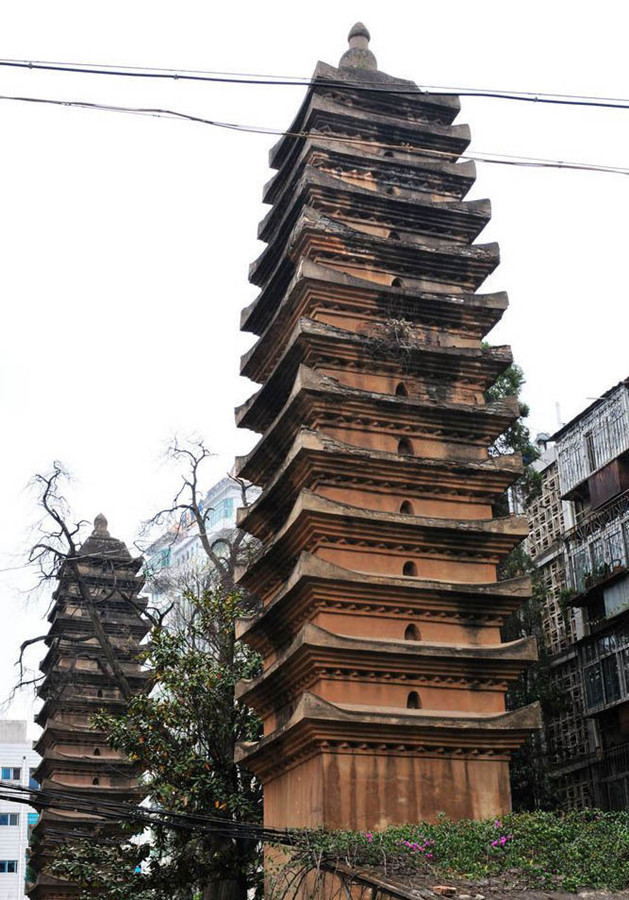
Dedesi Temple and Twins Pagodas in Kunming
Overview
The Dedesi Temple (大德寺) and its renowned Twins Pagodas (双塔) are located on Huashan East Road (华山东路), atop Zupian Mountain (祖遍山) on the eastern side of Wuhua Mountain (五华山), within the premises of the Yunnan Provincial Animal Husbandry Bureau (云南省畜牧局院内).
Originally built in the fifth year of the Yuan Dynasty (元大德五年, 1301), the temple was initially named “Palace of Ultimate Bliss” (极乐宫) before being renamed Dedesi. During the early Ming Dynasty, most of the temple’s buildings were destroyed, leaving only the front hall and the entrance. In the first year of the Tianshun era (明天顺元年, 1457), the recluse He Zhongyuan (何仲渊) oversaw significant renovations. Today, the temple is situated on Pingzheng Street (平政街). In 1983, it was approved by the Kunming Municipal People’s Government (昆明市人民政府) and designated as a city-level key cultural heritage site. Along with the East and West Pagodas (东、西寺塔), it serves as a symbol of Kunming’s ancient civilization.
Historical Significance
The Twins Pagodas (双塔) of Dedesi Temple are famous Buddhist towers within Kunming City (昆明市). Following the construction of the pagodas, Dedesi Temple became known as the Twins Pagoda Temple (双塔寺). Zupian Mountain, where Dedesi Temple is situated, is celebrated for its stunning scenery. The mountain is lush with ancient cypress trees, providing dense shade. From the top, visitors can enjoy panoramic views of the city, the charming forested hills, and the clear waters of Dianchi Lake (滇池).
Throughout the Ming and Qing Dynasties (明清), the temple underwent several renovations, becoming one of the largest Buddhist temples in Kunming City.
Construction and Structure
The Twins Pagodas were constructed in the thirteenth year of the Chenghua era of the Ming Dynasty (明成化十三年) and were modeled after the Small Wild Goose Pagoda (西安小雁塔) in Xi’an. They are located between the Hall of Reception (接引殿) and the Mahavira Hall (大雄宝殿). Each tower stands 21 meters tall, with a distance of 27 meters between them. They are solid square pagodas with a tiered eave design, featuring Buddha niches on all four sides of each level to house statues of Buddha, along with inscribed steles.
The pagodas have an unadorned yet dignified appearance, maintaining their integrity despite enduring over five hundred years of changes. In the late Qing Dynasty, the site of Dedesi Temple housed a mining school. During the Republic of China period, several educational institutions, including a Normal School, a Senior High School, an Agricultural School, Kunhua Women’s Teacher Training College, and Qiushi Middle School, were established there. The original structures of Dedesi Temple no longer exist, leaving only the Twins Pagodas.
During repairs in 1957, the entire tower was coated with cement, obscuring its original appearance. The top of the tower was also altered to a gourd shape made of cement, although the structure of the pagoda itself remained unchanged.
Scenic Introduction
In Kunming City, the East and West Pagodas stand to the south, while the Twins Pagodas gaze at them from a distance. The original Small Green Water River (小绿水河) and Large Green Water River (大绿水河) flowed beneath the pagodas, reflecting their beauty, earning them the title of “Green Reflecting Twins Pagodas” (绿映双塔). Along with the saying “Twins Pagodas in the Clouds, One Floor Touching the Sky” (双塔云中,一楼天际), they were praised as one of the top ten scenic spots in Kunming during the Ming and Qing Dynasties. Unfortunately, the original Songzi Tower (松子楼) no longer exists, leaving the Twins Pagodas standing tall.
The Qing Dynasty poet Zhu Xiaoyuan (朱筱园) wrote a poem titled “Twins Pagoda Temple” (《双塔寺》):
“Ancient temple set in the spiral peaks,
Exceedingly strange beyond Wuhua.
Two stupas float in the sky,
Bowing down to receive the worship of the chaotic mountains.
After many tribulations, the city still stands tall,
Enduring and unbroken.”
The Twins Pagodas are a prominent Buddhist tower within the city. Following their construction, Dedesi Temple gained the name of Twins Pagoda Temple. Zupian Mountain, where the temple is located, is known for its extraordinary scenic beauty, featuring dense ancient cypress trees that provide shade. From the top, visitors can admire the city’s layout, the beautiful forest scenery, and the clear waters of Dianchi Lake, all visible in one sweeping view.
Throughout the Ming and Qing Dynasties, the temple underwent multiple renovations and became one of the larger Buddhist temples in Kunming. The temple connects to the Yalong Shrine (盐龙祠) on the west side, attracting numerous worshippers and tourists throughout the year, making it one of the most popular ancient temples with active incense offerings.


 7 Days GolfingTour
7 Days GolfingTour
 8 Days Group Tour
8 Days Group Tour
 8 Days Yunnan Tour
8 Days Yunnan Tour
 7 Days Shangri La Hiking
7 Days Shangri La Hiking
 11 Days Yunnan Tour
11 Days Yunnan Tour
 6 Days Yuanyang Terraces
6 Days Yuanyang Terraces
 11 Days Yunnan Tour
11 Days Yunnan Tour
 8 Days South Yunnan
8 Days South Yunnan
 7 Days Tea Tour
7 Days Tea Tour
 8 Days Muslim Tour
8 Days Muslim Tour
 12 Days Self-Driving
12 Days Self-Driving
 4 Days Haba Climbing
4 Days Haba Climbing
 Tiger Leaping Gorge
Tiger Leaping Gorge
 Stone Forest
Stone Forest
 Yunnan-Tibet
Yunnan-Tibet
 Hani Rice Terraces
Hani Rice Terraces
 Kunming
Kunming
 Lijiang
Lijiang
 Shangri-la
Shangri-la
 Dali
Dali
 XishuangBanna
XishuangBanna
 Honghe
Honghe
 Kunming
Kunming
 Lijiang
Lijiang
 Shangri-la
Shangri-la
 Yuanyang Rice Terraces
Yuanyang Rice Terraces
 Nujiang
Nujiang
 XishuangBanna
XishuangBanna
 Spring City Golf
Spring City Golf
 Snow Mountain Golf
Snow Mountain Golf
 Stone Mountain Golf
Stone Mountain Golf
















